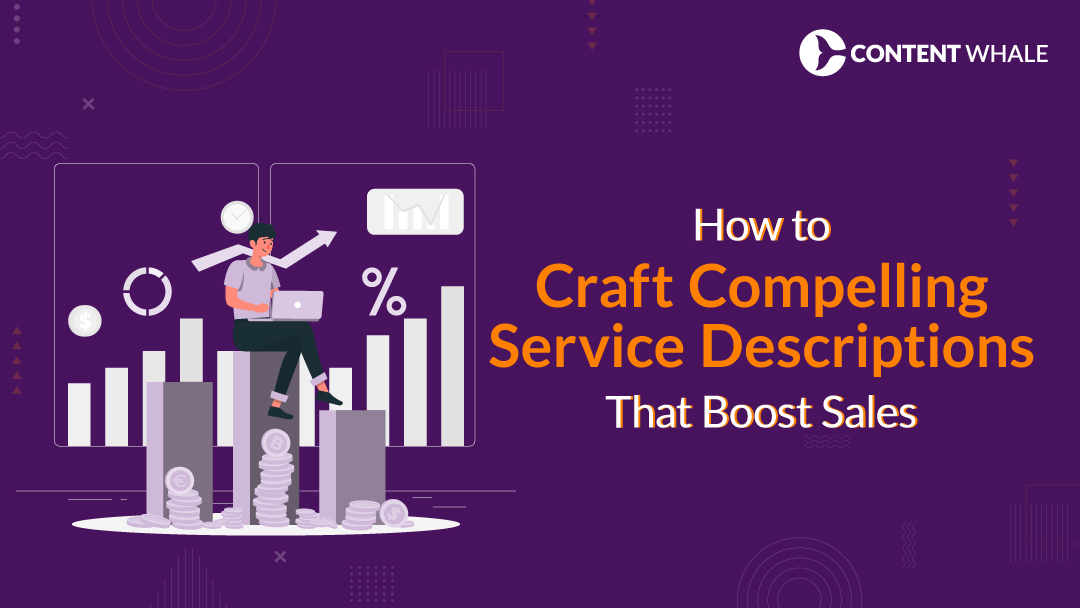Today’s digital marketplace demands that service descriptions do more than merely provide information; they must strategically engage and convert potential customers. Effective service descriptions bridge the gap between a company’s offerings and its audience, emphasizing not just the functionalities but the value these services bring. This engagement is crucial for compelling potential customers to take action.
Crafting descriptions that resonate requires more than a straightforward list of features. It involves demonstrating how these services can positively impact the customer. Such descriptions are essential for enhancing service description SEO by integrating relevant keywords. They also play a pivotal role in increasing conversion rates by highlighting the unique benefits and distinct value and persuasively encouraging visitors to act.
For businesses looking to strengthen their online presence, mastering the art of writing service descriptions is key. These descriptions should be clear, compelling, and strategically optimized for search engines. Based on our studies, they must also be specifically tailored to address the needs and interests of the target audience. In our experience, businesses can achieve this through a deep understanding of their audience, structuring their descriptions effectively, employing persuasive writing techniques, and avoiding common pitfalls. By crafting service descriptions for sales effectively, businesses can not only attract attention but significantly drive conversions.
Understanding Your Audience for Tailored Service Descriptions

1. Identifying Your Target Customer
To create compelling service descriptions, it’s crucial to thoroughly understand who your target customers are. This involves more than just demographic analysis; it requires a deep dive into their behaviors, needs, and expectations. Businesses need to gather and analyze data on their customers’ age, gender, income levels, education, and more.
Beyond demographics, understanding their pain points and purchasing behaviors is essential. This information forms the foundation of effective service descriptions that resonate with potential buyers.
When businesses understand their audience, they can craft service descriptions that not only meet but also anticipate and cater to the needs of their customers, significantly enhancing the relevance and appeal of their offerings.
2. The Role of Buyer Personas in Crafting Descriptions
In our experience, the creation and use of buyer personas are crucial for tailoring service descriptions effectively. These personas are detailed representations of ideal customers, constructed from both quantitative data and qualitative insights.
They include information about the customers’ backgrounds, daily activities, general behaviors, and specific pain points. This comprehensive understanding allows businesses to convert visitors with service descriptions by precisely targeting content to meet the nuanced needs of different customer segments.
Using buyer personas, businesses can specifically tailor their messaging within service descriptions to address direct concerns, aspirations, and typical scenarios that involve potential pain points.
For example, a persona for a tech service might focus on a customer’s desire for time efficiency and technological reliability, highlighting how the service uniquely addresses these needs. This approach ensures that the service descriptions not only capture the attention of potential buyers but also speak directly to their experiences and needs, making the content more engaging and persuasive.
Furthermore, by aligning the service features with the customer’s lifestyle and values, businesses can create more than just a functional description; they can weave a narrative that positions their services as essential solutions to common problems.
This strategic alignment is key to effective service description SEO, as it ensures the content is both relevant to the consumer and optimized for search engines.
Effective writing service descriptions involves a balance of SEO skills and a deep understanding of the target audience. This balance helps in crafting descriptions that do not just inform but actively engage and persuade potential customers to make a purchase.
By leveraging detailed buyer personas and understanding the customer’s decision-making process, businesses can craft service descriptions that are not only informative but also compelling enough to drive conversions.
By strategically utilizing audience insights and detailed buyer personas, businesses can significantly enhance the effectiveness of their crafting service descriptions for sales. The goal is to ensure that these descriptions are not mere lists of service features but persuasive content that effectively converts readers into buyers.
The Anatomy of a Successful Service Description

1. Key Elements of Service Descriptions
Creating a successful service description requires a well-structured approach that highlights key elements designed to attract and engage potential customers. The first component is a clear outline of the service’s features—what exactly the service offers, explained in a straightforward manner.
However, merely listing features is not enough; it’s crucial to also explain the benefits. Here, the focus shifts from what the service does to how it benefits the user, addressing specific problems and offering solutions.
Additionally, emphasizing the Unique Selling Propositions (USPs) is essential. These are the features or aspects that set your service apart from competitors, which can be a decisive factor for customers when choosing between similar options.
2. Writing Techniques to Enhance Clarity and Persuasiveness
To write effective and persuasive service descriptions, businesses must adopt specific writing techniques that enhance clarity and engage the reader. Utilizing an active voice is one of these techniques, as it makes the content more dynamic and direct, effectively drawing the reader’s attention.
Also, employing persuasive language that connects with the reader emotionally and logically can significantly increase the impact of the description. It’s crucial to avoid industry jargon that might confuse the audience. Instead, use clear and simple language that enhances understanding and retention.
This approach not only helps in keeping the reader engaged but also ensures that the key messages are communicated effectively.
3. SEO Optimization for Service Descriptions
Service description SEO is a critical aspect of writing descriptions that not only attract but also convert. It involves the strategic placement of primary and secondary keywords such as effective service descriptions, writing service descriptions, and convert visitors with service descriptions throughout the content without resorting to keyword stuffing.
This SEO practice helps in improving the visibility of the service descriptions on search engines, thereby increasing the likelihood of attracting more visitors.
Moreover, it’s important to structure the description with SEO-friendly formatting, including the use of headings, subheadings, and bullet points, which enhances readability and further supports SEO efforts.
Effective crafting service descriptions for sales involves a blend of clear communication, persuasive writing, and strategic SEO practices. By focusing on these elements, businesses can create service descriptions that are not only informative but also compelling enough to drive conversions.
This balanced approach ensures that the descriptions perform well in search engines while also resonating with the target audience, ultimately leading to increased sales and customer engagement.
Practical Examples and Case Studies on Service Descriptions that Converts and Boost Sales

1. Examples of Effective Service Descriptions
To illustrate how businesses can craft compelling service descriptions that convert well, let’s consider a few industry examples that highlight best practices.
- Roofing Service: A family-owned roofing business effectively showcases over 60 years of experience in their service description, emphasizing reliability and expertise. They directly address common customer issues like leaks and missing shingles, promising swift and dependable repairs, thus underscoring their service reliability.
- Mechanic’s Shop: Another practical example comes from a mechanic’s shop that ensures transparency in its services. The description emphasizes honesty, a direct appeal to customer concerns about overcharging. They highlight their approach by promising to show the damages to customers first, ensuring they pay only for what is necessary, which is supported by a six-month guarantee on repairs.
These examples demonstrate how businesses use their service descriptions to not only inform but also reassure and build trust with potential customers by addressing common concerns and highlighting specific benefits.
2. Case Studies on Service Descriptions That Converted Well
Several case studies reveal the effectiveness of strategically crafted service descriptions:
- Digital Marketing Services: One digital marketing service revised its service descriptions to emphasize comprehensive packages tailored for small businesses, highlighting ease of use and all-in-one solutions. This clear communication of benefits led to a significant increase in engagement and conversions from small business owners looking for streamlined marketing solutions.
- Boutique Hotel: In the hospitality sector, a boutique hotel differentiated itself by focusing on unique local experiences, such as custom culinary tours and private historical walks. This not only set the hotel apart from bigger chains but also attracted travelers looking for personalized experiences, resulting in higher booking rates.
These case studies underline the importance of understanding customer needs and preferences, and how a well-constructed service description can effectively address these points to improve sales outcomes. By focusing on unique selling propositions and clearly communicating benefits, businesses can significantly enhance the effectiveness of their service descriptions.
Common Mistakes to Avoid While Writing Service Descriptions

1. Overlooking the Importance of SEO
A significant mistake in writing service descriptions is underestimating the impact of service description SEO. Many businesses overlook the necessity to optimize their descriptions effectively, missing out on opportunities to draw more online traffic. Proper SEO isn’t just about inserting keywords; it requires integrating them naturally into engaging and informative content. Failing to incorporate SEO strategies adequately can lead to lower visibility on search engines, substantially reducing the chances of engaging potential customers and making sales.
2. Neglecting the Customer’s Perspective
Neglecting the customer’s perspective is another oversight businesses often make when crafting service descriptions for sales. Descriptions should not just list service features but also explain how these features can solve customer problems or improve their circumstances. It’s essential to craft content from the potential customer’s viewpoint, emphasizing benefits and outcomes. Service descriptions that focus solely on technical details or company-centric information often fail to resonate with the audience, significantly lowering conversion chances.
3. Being too Technical or Verbose
Another common pitfall is creating overly technical or verbose service descriptions. While it’s important to provide sufficient detail to inform the customer, too much complexity can be off-putting. Based on our studies, customers prefer clear and concise descriptions that quickly communicate service value without bogging them down with jargon or excessive information. Achieving this balance is crucial; it ensures that descriptions are both informative and accessible, making them more likely to convert visitors with service descriptions.
By steering clear of these common errors and focusing on optimized, customer-centric, and straightforward service descriptions, businesses can greatly enhance their ability to engage and convert their audience. The aim is to clearly communicate the value of the service in a manner that connects with and persuades the target audience, compelling them to act.
Advanced Tips for Maximizing Impact

1. Using Multimedia Elements to Complement Text
In our experience, incorporating multimedia elements such as images, videos, and infographics alongside text can significantly enhance the effectiveness of service descriptions. These elements help to break up text, making the content more engaging and easier to digest.
Visual aids not only attract attention but also aid in better understanding complex information about services, which can be crucial in persuading potential customers. By complementing textual content with multimedia, businesses can provide a richer experience that can lead to higher engagement and conversion rates.
2. Leveraging Social Proof and Testimonials
Based on our studies, integrating social proof and testimonials within service descriptions effectively boosts credibility and trust. Customer reviews and endorsements act as powerful tools for persuasion, as they demonstrate the value and effectiveness of a service from the perspective of others who have already benefited.
Highlighting positive customer experiences can significantly influence potential customers’ decision-making processes. It’s important to strategically place these testimonials where they can have the most impact, such as near key benefits or call-to-action buttons.
Both of these advanced techniques—using multimedia to complement text and leveraging social proof—are essential for businesses looking to convert visitors with service descriptions.
By employing these strategies, companies can create more dynamic and persuasive descriptions that not only inform but also build trust and encourage action. These elements are part of a comprehensive approach to crafting service descriptions for sales, aiming to captivate and convert the audience effectively.

To wrap up, we’ve explored a variety of strategies and techniques essential for crafting compelling service descriptions that not only draw attention but also drive conversions. By understanding your audience deeply and structuring your descriptions effectively, you can create content that resonates strongly with potential customers. Moreover, employing persuasive writing techniques and avoiding common pitfalls enhances the impact of your descriptions, making them more likely to convert visitors.
Remember, the effectiveness of your service descriptions hinges not just on the information provided but on how it’s presented. Incorporating SEO best practices, focusing on customer-centric benefits, and using multimedia elements can significantly enhance the appeal and effectiveness of your descriptions. Additionally, leveraging social proof and testimonials adds a layer of trust and authenticity, which can be decisive in a customer’s purchasing journey.
We encourage businesses to experiment with these different techniques to find what best suits their unique services and target audience. Continuous refinement and adaptation to feedback and results are key to finding the most effective approach. By doing so, you can ensure that your service descriptions are not only informative and SEO-friendly but also compelling enough to convert readers into loyal customers.

What are the top three tips for writing effective service descriptions?
- Focus on Benefits: Always highlight how the service can solve problems or improve the customer’s situation. This approach shifts the focus from what the service does to how it benefits the user, making the description more relevant and compelling.
- Incorporate SEO Strategically: Utilize service description SEO practices by naturally integrating keywords and optimizing content structure. This ensures that your descriptions are not only engaging but also visible in search engine results.
- Use Clear and Persuasive Language: Opt for simple, direct language that communicates value effectively. Avoid technical jargon and aim to persuade by clearly stating the advantages of your services.
How often should I update my service descriptions?
Service descriptions should be updated whenever there is a change in your service offerings or to reflect customer feedback and market trends. Regular updates ensure that your descriptions remain relevant and optimized for the best SEO performance.
Can the length of a service description affect SEO and conversion rates?
Yes, the length of a service description can impact both SEO and conversion rates. A well-balanced description that is neither too short nor too verbose tends to perform best. It should be long enough to include essential keywords and convey key benefits, but concise enough to maintain the reader’s interest.
What is the role of keywords in service descriptions?
Keywords play a crucial role in service descriptions by helping to improve search engine rankings and by ensuring that the content is discoverable by the right audience. However, it’s important to use them judically to avoid keyword stuffing, which can harm readability and SEO.
How can I measure the effectiveness of my service descriptions?
The effectiveness of service descriptions can be measured through various metrics such as engagement rates, conversion rates, and search engine rankings. Tools like Google Analytics can track how visitors interact with your descriptions and whether they lead to desired actions such as purchases or inquiries. Regularly reviewing these metrics allows you to refine and optimize your descriptions based on actual performance.





